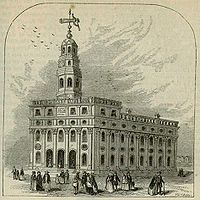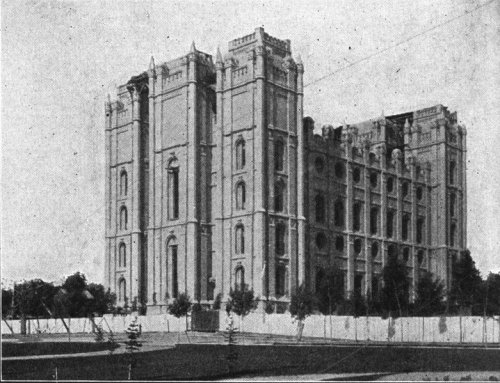Truman O. Angell
Truman O. Angell was born June 5, 1810, in Providence, Rhode Island, the third son of seven children born to James W. Angell and Phebe Morton. Between the ages of 17 and 19, he learned the carpenter and joiner's trade from a man in the neighborhood of his family home. However, due to problems that his mother had with his father, at age 21 he moved with his mother to China, New York (near her family), where he met and married Polly Johnson. Truman's sister Mary Ann Angell married Brigham Young. At age 23, along with his wife and his mother, he joined the Mormon Church.
Angell served many years as the artchitect for The Church of Jesus Christ of Latter-day Saints. In the fall of 1835 he and his wife moved to Kirtland, Ohio, and Angell helped build the Kirtland Temple. He was soon ordained a member of the Quorum of Seventies and the following spring commenced making arrangements to go on a mission. In council with the Prophet Joseph Smith, however, he returned from the mission field to build a store. As a member of the Seventies, Angell felt he should be proselyting, but the Spirit kept prompting him to stay behind and work on building. Angell recorded, "The numerous and continued calls to do this and that job soon plunged me in business so deep that I asked Brother Joseph if it was my calling to work at home. He said, 'I'll give you work enough for twenty men'" (Autobiography of Truman O. Angell).
Angell moved his family to Far West, Missouri, with the Saints, and then to Nauvoo, Illinois. Angell later went on to work on the Nauvoo Temple, having been appointed superintendent of joiner work under Church Architect William Weeks, carrying out the architect's designs in the construction of that temple. On the construction of the Nauvoo Temple Angell served as the superintendent of the joiners.
He migrated west to the Salt Lake Valley with the first group of pioneers in 1847, leaving his wife and family behind in Winter Quarters. Angell then returned to Winter Quarters in the fall of 1847. Three of his children died and were buried in Winter Quarters, and he entered the Salt Lake Valley with his sick wife and his remaining two children.
Angell was appointed Church Architect by Brigham Young on January 26th, 1850. Before that he was the "Architect of Public Works" in Great Salt Lake City. Angell painted a bit as a nonprofessional, but rather able landscapist in his spare time. In 1851, Angell polygamously married his only other wife, Susan Eliza Savage, who had been a textile worker in the Lowell, Massachusetts cotton mills in the early 1840s until she migrated to Salt Lake after joining the LDS Church.
He designed the Salt Lake Temple, the Lion House, the Beehive House, the Utah Territorial Statehouse, the St. George Utah Temple, and many other important public buildings. (See Temple Square.) His modifications to the Salt Lake Tabernacle are credited with perfecting the acoustics for which the building is famous. Angell was too far away from the locations of the Logan and Manti Temples to assist in the building. His son, Truman O. Angell, Jr., managed the Logan Temple construction, with William H. Fulsom supervising construction of the Manti Temple. After the Logan Temple was completed, Angell's son returned to help with the Salt Lake Temple.
In April 1856, Brigham Young asked Angell to leave his family and go to Europe so that he could learn the architectural designs there. After he returned from his mission to Europe, he continued to labor on the Salt Lake Temple. From 1861-1867 Angell had stepped down as Church Architect due to poor health and was replaced by William Folsom. However in April 1867 Angell was again sustained as church architect. Even during the time that he was not church architect, Angell worked closely with the construction of the Salt Lake Temple. He continued to serve as Church Architect until his death on October 16, 1887, at the age of 77. For more than thirty-five years he had worked on the Salt Lake Temple. It was said that he knew every stone in its walls. Of Truman O. Angell, Wendell Ashton wrote: "As long as the Salt Lake Temple stands, there will be a magnificent monument to the patience, skill and dedication of its architect." Although Angell did not live to see the temple completed, he was a key mover behind its being built (Wikipedia.org).

